Emerging Themes: Digital Disruption Impact on Oil and Gas Sector
VerifiedAdded on 2020/04/21
|8
|1973
|96
Report
AI Summary
This report critically analyzes the impact of digital disruption on the oil and gas industry. It identifies digital disruption as a key theme, defining it as the influence of digital technologies on existing goods and services. The report discusses the significance of digital transformation in the oil and gas sector, highlighting the adoption of new technologies for production potential, efficiency improvements, and cost reduction. It explores how digital disruption affects consumer needs, environmental concerns, and market dynamics. The report examines four key technologies expected to impact the sector over the next few decades, including digital asset life cycle management, circular collaborative ecosystems, technologies beyond the barrel, and new energy sources. The analysis also focuses on the need for oil and gas companies to develop business strategies that incorporate digital priorities, innovation, data infrastructure, and collaboration. The report concludes by emphasizing the importance of embracing digital technologies, formulating appropriate strategies, and meeting changing customer requirements to ensure operational improvements.
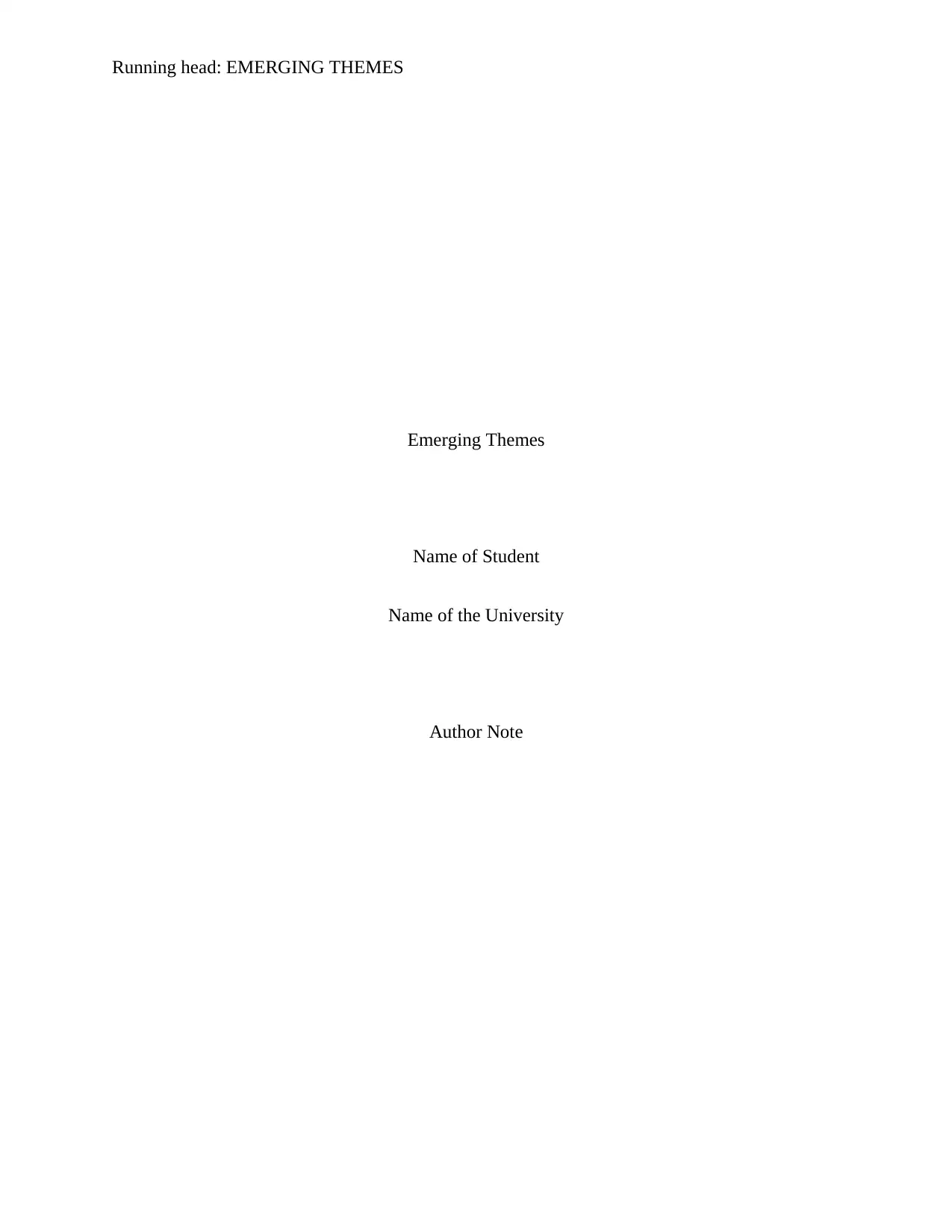
Running head: EMERGING THEMES
Emerging Themes
Name of Student
Name of the University
Author Note
Emerging Themes
Name of Student
Name of the University
Author Note
Paraphrase This Document
Need a fresh take? Get an instant paraphrase of this document with our AI Paraphraser
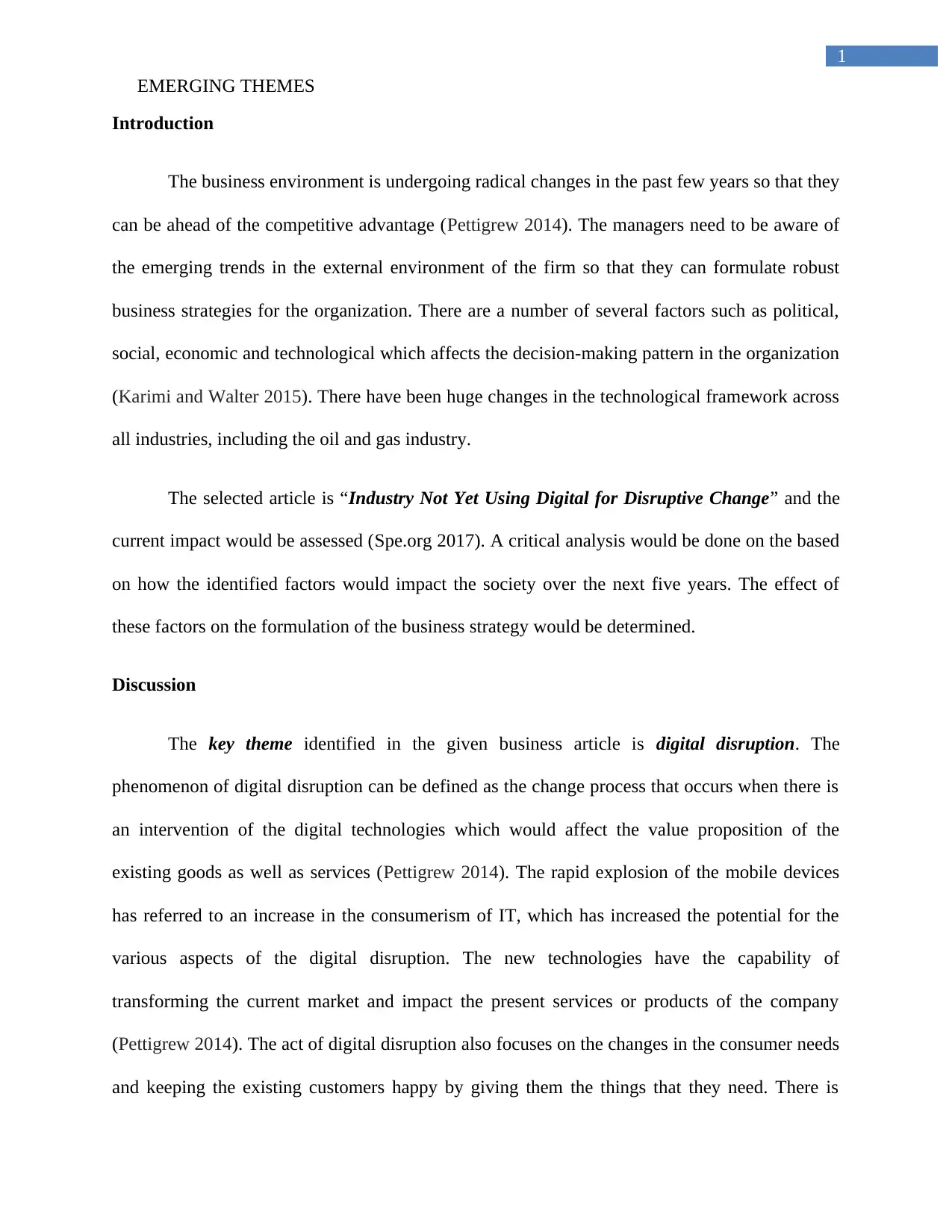
1
EMERGING THEMES
Introduction
The business environment is undergoing radical changes in the past few years so that they
can be ahead of the competitive advantage (Pettigrew 2014). The managers need to be aware of
the emerging trends in the external environment of the firm so that they can formulate robust
business strategies for the organization. There are a number of several factors such as political,
social, economic and technological which affects the decision-making pattern in the organization
(Karimi and Walter 2015). There have been huge changes in the technological framework across
all industries, including the oil and gas industry.
The selected article is “Industry Not Yet Using Digital for Disruptive Change” and the
current impact would be assessed (Spe.org 2017). A critical analysis would be done on the based
on how the identified factors would impact the society over the next five years. The effect of
these factors on the formulation of the business strategy would be determined.
Discussion
The key theme identified in the given business article is digital disruption. The
phenomenon of digital disruption can be defined as the change process that occurs when there is
an intervention of the digital technologies which would affect the value proposition of the
existing goods as well as services (Pettigrew 2014). The rapid explosion of the mobile devices
has referred to an increase in the consumerism of IT, which has increased the potential for the
various aspects of the digital disruption. The new technologies have the capability of
transforming the current market and impact the present services or products of the company
(Pettigrew 2014). The act of digital disruption also focuses on the changes in the consumer needs
and keeping the existing customers happy by giving them the things that they need. There is
EMERGING THEMES
Introduction
The business environment is undergoing radical changes in the past few years so that they
can be ahead of the competitive advantage (Pettigrew 2014). The managers need to be aware of
the emerging trends in the external environment of the firm so that they can formulate robust
business strategies for the organization. There are a number of several factors such as political,
social, economic and technological which affects the decision-making pattern in the organization
(Karimi and Walter 2015). There have been huge changes in the technological framework across
all industries, including the oil and gas industry.
The selected article is “Industry Not Yet Using Digital for Disruptive Change” and the
current impact would be assessed (Spe.org 2017). A critical analysis would be done on the based
on how the identified factors would impact the society over the next five years. The effect of
these factors on the formulation of the business strategy would be determined.
Discussion
The key theme identified in the given business article is digital disruption. The
phenomenon of digital disruption can be defined as the change process that occurs when there is
an intervention of the digital technologies which would affect the value proposition of the
existing goods as well as services (Pettigrew 2014). The rapid explosion of the mobile devices
has referred to an increase in the consumerism of IT, which has increased the potential for the
various aspects of the digital disruption. The new technologies have the capability of
transforming the current market and impact the present services or products of the company
(Pettigrew 2014). The act of digital disruption also focuses on the changes in the consumer needs
and keeping the existing customers happy by giving them the things that they need. There is
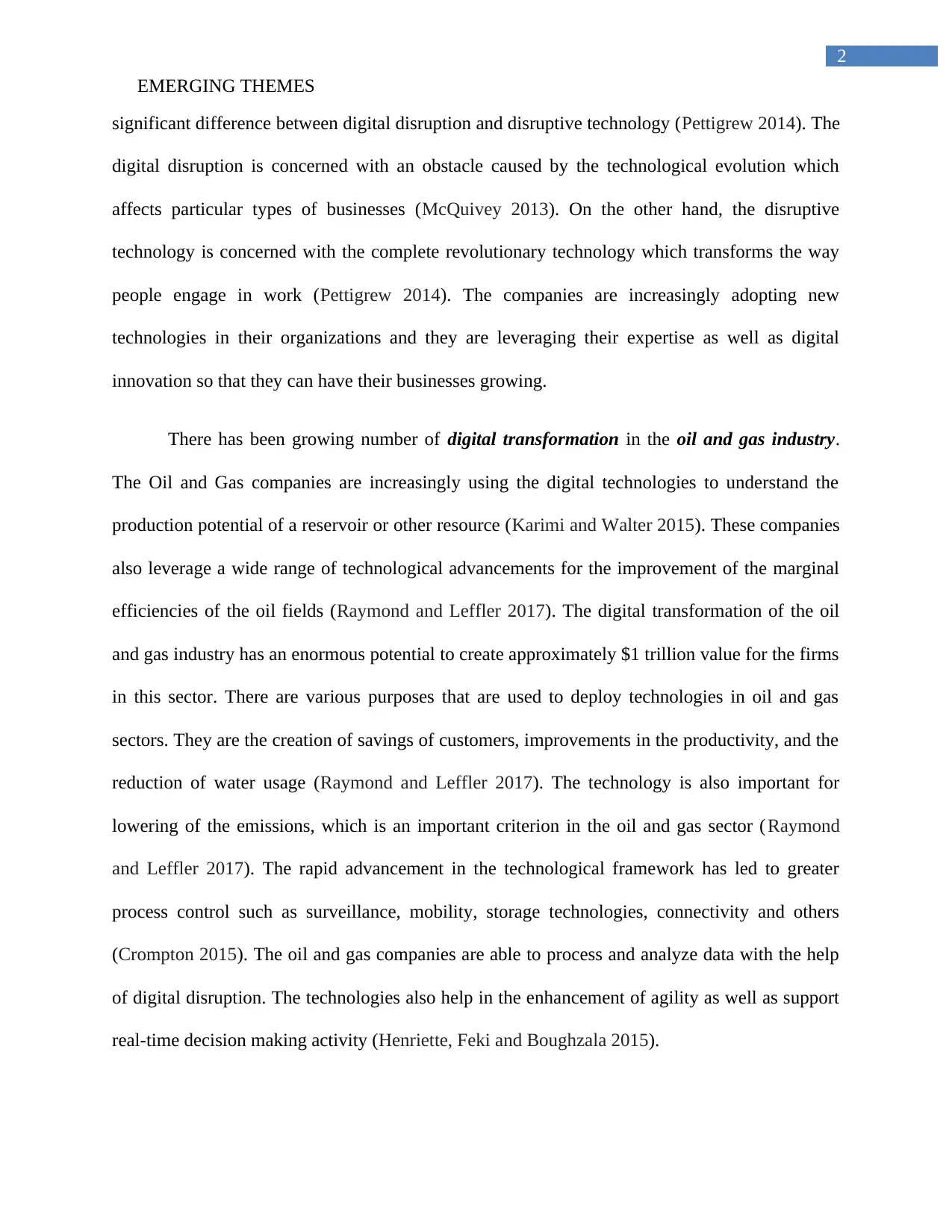
2
EMERGING THEMES
significant difference between digital disruption and disruptive technology (Pettigrew 2014). The
digital disruption is concerned with an obstacle caused by the technological evolution which
affects particular types of businesses (McQuivey 2013). On the other hand, the disruptive
technology is concerned with the complete revolutionary technology which transforms the way
people engage in work (Pettigrew 2014). The companies are increasingly adopting new
technologies in their organizations and they are leveraging their expertise as well as digital
innovation so that they can have their businesses growing.
There has been growing number of digital transformation in the oil and gas industry.
The Oil and Gas companies are increasingly using the digital technologies to understand the
production potential of a reservoir or other resource (Karimi and Walter 2015). These companies
also leverage a wide range of technological advancements for the improvement of the marginal
efficiencies of the oil fields (Raymond and Leffler 2017). The digital transformation of the oil
and gas industry has an enormous potential to create approximately $1 trillion value for the firms
in this sector. There are various purposes that are used to deploy technologies in oil and gas
sectors. They are the creation of savings of customers, improvements in the productivity, and the
reduction of water usage (Raymond and Leffler 2017). The technology is also important for
lowering of the emissions, which is an important criterion in the oil and gas sector ( Raymond
and Leffler 2017). The rapid advancement in the technological framework has led to greater
process control such as surveillance, mobility, storage technologies, connectivity and others
(Crompton 2015). The oil and gas companies are able to process and analyze data with the help
of digital disruption. The technologies also help in the enhancement of agility as well as support
real-time decision making activity (Henriette, Feki and Boughzala 2015).
EMERGING THEMES
significant difference between digital disruption and disruptive technology (Pettigrew 2014). The
digital disruption is concerned with an obstacle caused by the technological evolution which
affects particular types of businesses (McQuivey 2013). On the other hand, the disruptive
technology is concerned with the complete revolutionary technology which transforms the way
people engage in work (Pettigrew 2014). The companies are increasingly adopting new
technologies in their organizations and they are leveraging their expertise as well as digital
innovation so that they can have their businesses growing.
There has been growing number of digital transformation in the oil and gas industry.
The Oil and Gas companies are increasingly using the digital technologies to understand the
production potential of a reservoir or other resource (Karimi and Walter 2015). These companies
also leverage a wide range of technological advancements for the improvement of the marginal
efficiencies of the oil fields (Raymond and Leffler 2017). The digital transformation of the oil
and gas industry has an enormous potential to create approximately $1 trillion value for the firms
in this sector. There are various purposes that are used to deploy technologies in oil and gas
sectors. They are the creation of savings of customers, improvements in the productivity, and the
reduction of water usage (Raymond and Leffler 2017). The technology is also important for
lowering of the emissions, which is an important criterion in the oil and gas sector ( Raymond
and Leffler 2017). The rapid advancement in the technological framework has led to greater
process control such as surveillance, mobility, storage technologies, connectivity and others
(Crompton 2015). The oil and gas companies are able to process and analyze data with the help
of digital disruption. The technologies also help in the enhancement of agility as well as support
real-time decision making activity (Henriette, Feki and Boughzala 2015).
⊘ This is a preview!⊘
Do you want full access?
Subscribe today to unlock all pages.

Trusted by 1+ million students worldwide
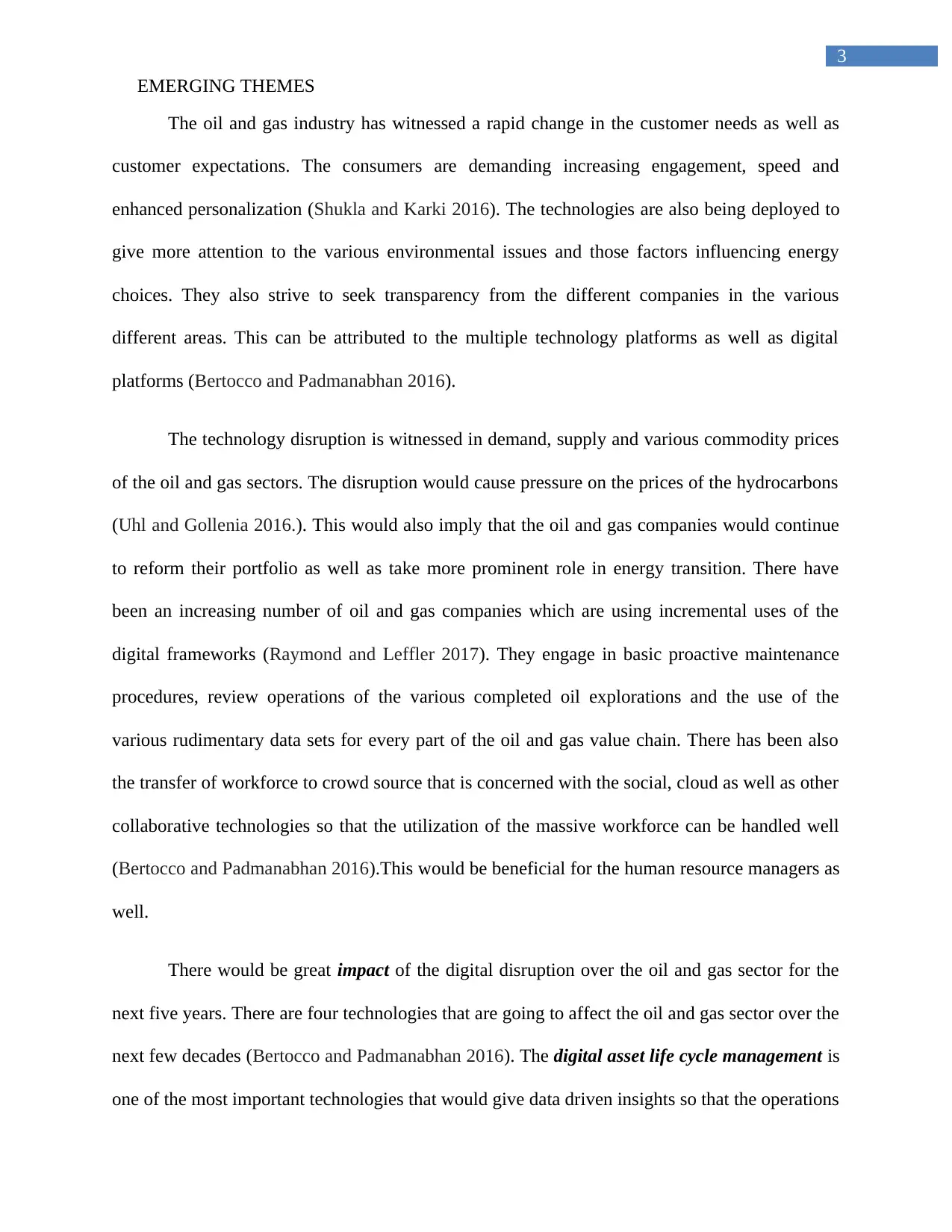
3
EMERGING THEMES
The oil and gas industry has witnessed a rapid change in the customer needs as well as
customer expectations. The consumers are demanding increasing engagement, speed and
enhanced personalization (Shukla and Karki 2016). The technologies are also being deployed to
give more attention to the various environmental issues and those factors influencing energy
choices. They also strive to seek transparency from the different companies in the various
different areas. This can be attributed to the multiple technology platforms as well as digital
platforms (Bertocco and Padmanabhan 2016).
The technology disruption is witnessed in demand, supply and various commodity prices
of the oil and gas sectors. The disruption would cause pressure on the prices of the hydrocarbons
(Uhl and Gollenia 2016.). This would also imply that the oil and gas companies would continue
to reform their portfolio as well as take more prominent role in energy transition. There have
been an increasing number of oil and gas companies which are using incremental uses of the
digital frameworks (Raymond and Leffler 2017). They engage in basic proactive maintenance
procedures, review operations of the various completed oil explorations and the use of the
various rudimentary data sets for every part of the oil and gas value chain. There has been also
the transfer of workforce to crowd source that is concerned with the social, cloud as well as other
collaborative technologies so that the utilization of the massive workforce can be handled well
(Bertocco and Padmanabhan 2016).This would be beneficial for the human resource managers as
well.
There would be great impact of the digital disruption over the oil and gas sector for the
next five years. There are four technologies that are going to affect the oil and gas sector over the
next few decades (Bertocco and Padmanabhan 2016). The digital asset life cycle management is
one of the most important technologies that would give data driven insights so that the operations
EMERGING THEMES
The oil and gas industry has witnessed a rapid change in the customer needs as well as
customer expectations. The consumers are demanding increasing engagement, speed and
enhanced personalization (Shukla and Karki 2016). The technologies are also being deployed to
give more attention to the various environmental issues and those factors influencing energy
choices. They also strive to seek transparency from the different companies in the various
different areas. This can be attributed to the multiple technology platforms as well as digital
platforms (Bertocco and Padmanabhan 2016).
The technology disruption is witnessed in demand, supply and various commodity prices
of the oil and gas sectors. The disruption would cause pressure on the prices of the hydrocarbons
(Uhl and Gollenia 2016.). This would also imply that the oil and gas companies would continue
to reform their portfolio as well as take more prominent role in energy transition. There have
been an increasing number of oil and gas companies which are using incremental uses of the
digital frameworks (Raymond and Leffler 2017). They engage in basic proactive maintenance
procedures, review operations of the various completed oil explorations and the use of the
various rudimentary data sets for every part of the oil and gas value chain. There has been also
the transfer of workforce to crowd source that is concerned with the social, cloud as well as other
collaborative technologies so that the utilization of the massive workforce can be handled well
(Bertocco and Padmanabhan 2016).This would be beneficial for the human resource managers as
well.
There would be great impact of the digital disruption over the oil and gas sector for the
next five years. There are four technologies that are going to affect the oil and gas sector over the
next few decades (Bertocco and Padmanabhan 2016). The digital asset life cycle management is
one of the most important technologies that would give data driven insights so that the operations
Paraphrase This Document
Need a fresh take? Get an instant paraphrase of this document with our AI Paraphraser
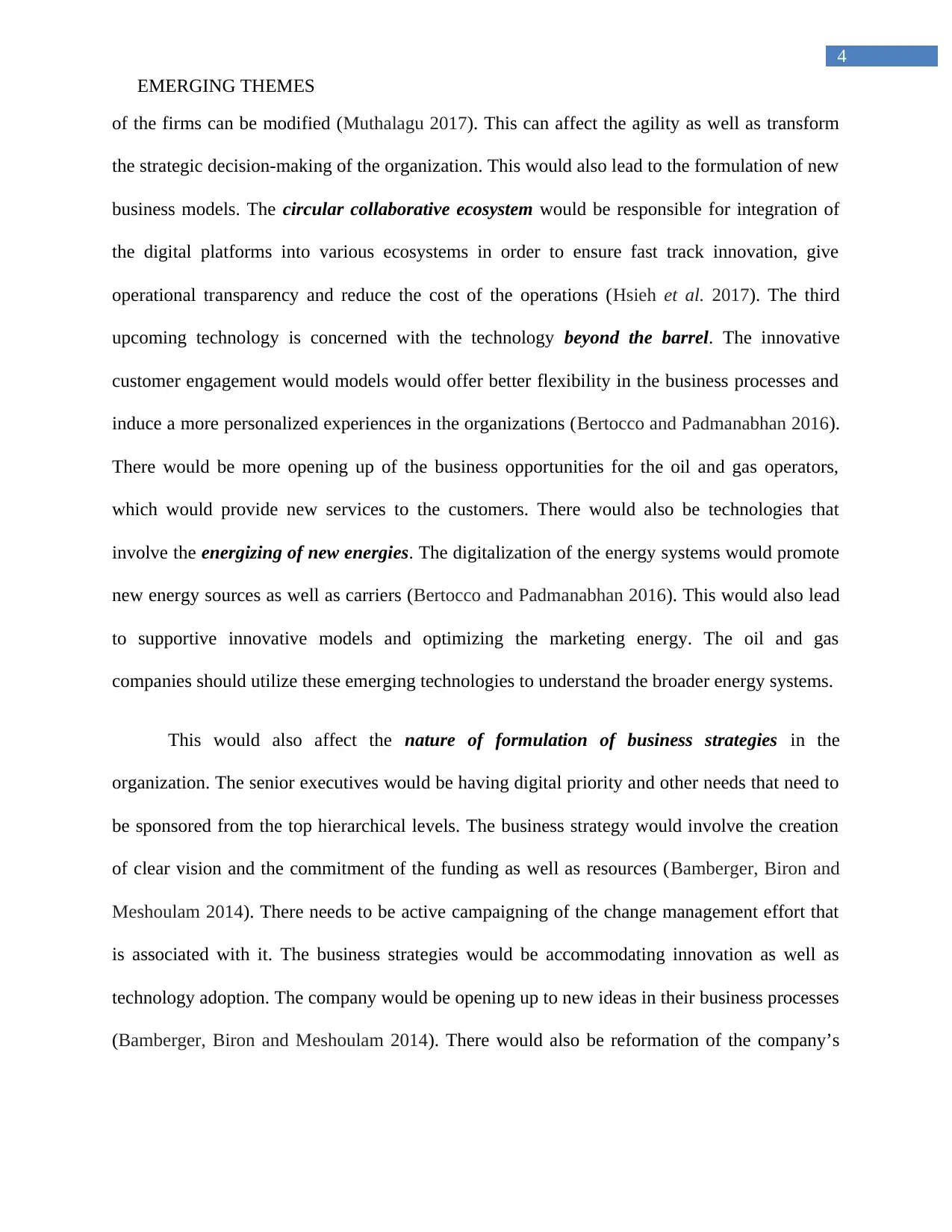
4
EMERGING THEMES
of the firms can be modified (Muthalagu 2017). This can affect the agility as well as transform
the strategic decision-making of the organization. This would also lead to the formulation of new
business models. The circular collaborative ecosystem would be responsible for integration of
the digital platforms into various ecosystems in order to ensure fast track innovation, give
operational transparency and reduce the cost of the operations (Hsieh et al. 2017). The third
upcoming technology is concerned with the technology beyond the barrel. The innovative
customer engagement would models would offer better flexibility in the business processes and
induce a more personalized experiences in the organizations (Bertocco and Padmanabhan 2016).
There would be more opening up of the business opportunities for the oil and gas operators,
which would provide new services to the customers. There would also be technologies that
involve the energizing of new energies. The digitalization of the energy systems would promote
new energy sources as well as carriers (Bertocco and Padmanabhan 2016). This would also lead
to supportive innovative models and optimizing the marketing energy. The oil and gas
companies should utilize these emerging technologies to understand the broader energy systems.
This would also affect the nature of formulation of business strategies in the
organization. The senior executives would be having digital priority and other needs that need to
be sponsored from the top hierarchical levels. The business strategy would involve the creation
of clear vision and the commitment of the funding as well as resources (Bamberger, Biron and
Meshoulam 2014). There needs to be active campaigning of the change management effort that
is associated with it. The business strategies would be accommodating innovation as well as
technology adoption. The company would be opening up to new ideas in their business processes
(Bamberger, Biron and Meshoulam 2014). There would also be reformation of the company’s
EMERGING THEMES
of the firms can be modified (Muthalagu 2017). This can affect the agility as well as transform
the strategic decision-making of the organization. This would also lead to the formulation of new
business models. The circular collaborative ecosystem would be responsible for integration of
the digital platforms into various ecosystems in order to ensure fast track innovation, give
operational transparency and reduce the cost of the operations (Hsieh et al. 2017). The third
upcoming technology is concerned with the technology beyond the barrel. The innovative
customer engagement would models would offer better flexibility in the business processes and
induce a more personalized experiences in the organizations (Bertocco and Padmanabhan 2016).
There would be more opening up of the business opportunities for the oil and gas operators,
which would provide new services to the customers. There would also be technologies that
involve the energizing of new energies. The digitalization of the energy systems would promote
new energy sources as well as carriers (Bertocco and Padmanabhan 2016). This would also lead
to supportive innovative models and optimizing the marketing energy. The oil and gas
companies should utilize these emerging technologies to understand the broader energy systems.
This would also affect the nature of formulation of business strategies in the
organization. The senior executives would be having digital priority and other needs that need to
be sponsored from the top hierarchical levels. The business strategy would involve the creation
of clear vision and the commitment of the funding as well as resources (Bamberger, Biron and
Meshoulam 2014). There needs to be active campaigning of the change management effort that
is associated with it. The business strategies would be accommodating innovation as well as
technology adoption. The company would be opening up to new ideas in their business processes
(Bamberger, Biron and Meshoulam 2014). There would also be reformation of the company’s
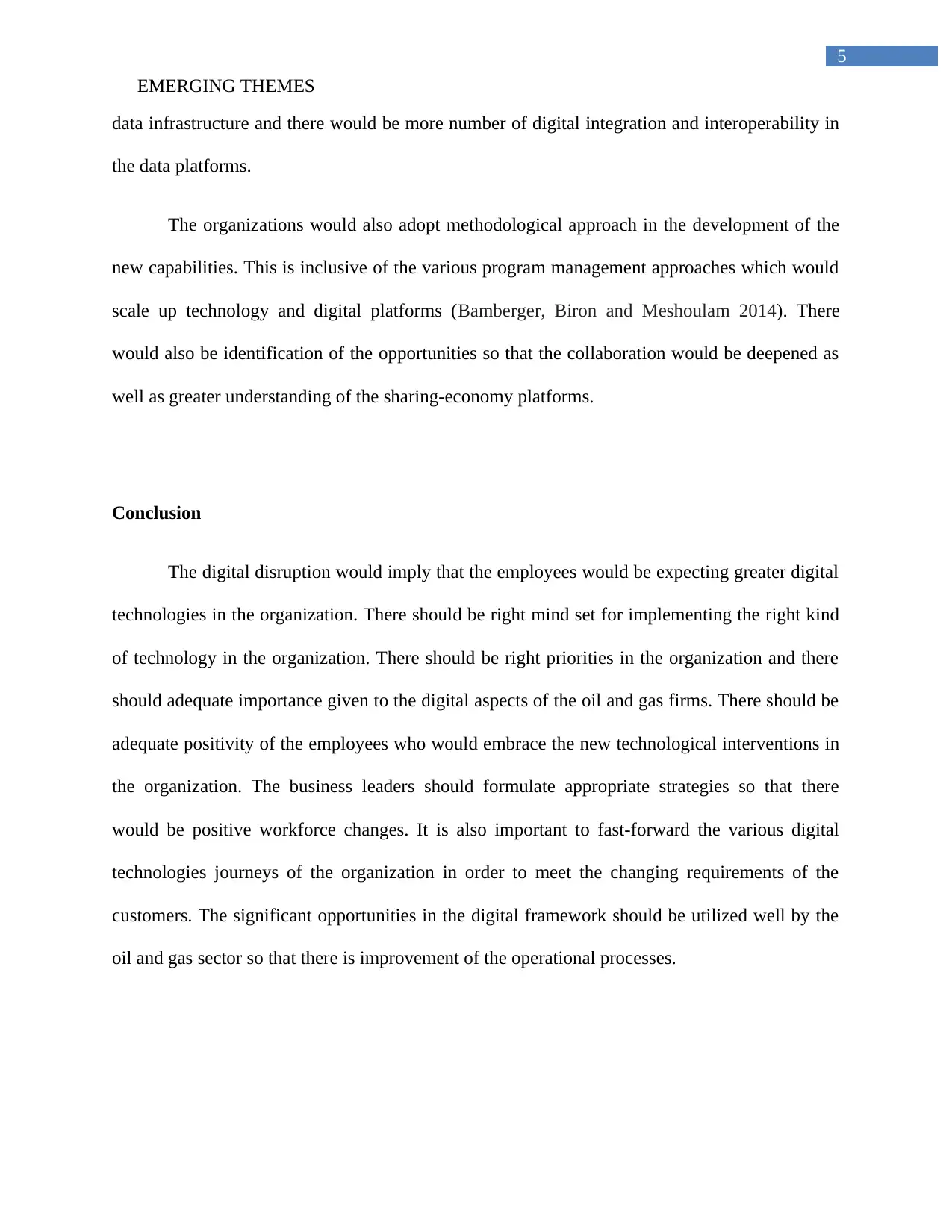
5
EMERGING THEMES
data infrastructure and there would be more number of digital integration and interoperability in
the data platforms.
The organizations would also adopt methodological approach in the development of the
new capabilities. This is inclusive of the various program management approaches which would
scale up technology and digital platforms (Bamberger, Biron and Meshoulam 2014). There
would also be identification of the opportunities so that the collaboration would be deepened as
well as greater understanding of the sharing-economy platforms.
Conclusion
The digital disruption would imply that the employees would be expecting greater digital
technologies in the organization. There should be right mind set for implementing the right kind
of technology in the organization. There should be right priorities in the organization and there
should adequate importance given to the digital aspects of the oil and gas firms. There should be
adequate positivity of the employees who would embrace the new technological interventions in
the organization. The business leaders should formulate appropriate strategies so that there
would be positive workforce changes. It is also important to fast-forward the various digital
technologies journeys of the organization in order to meet the changing requirements of the
customers. The significant opportunities in the digital framework should be utilized well by the
oil and gas sector so that there is improvement of the operational processes.
EMERGING THEMES
data infrastructure and there would be more number of digital integration and interoperability in
the data platforms.
The organizations would also adopt methodological approach in the development of the
new capabilities. This is inclusive of the various program management approaches which would
scale up technology and digital platforms (Bamberger, Biron and Meshoulam 2014). There
would also be identification of the opportunities so that the collaboration would be deepened as
well as greater understanding of the sharing-economy platforms.
Conclusion
The digital disruption would imply that the employees would be expecting greater digital
technologies in the organization. There should be right mind set for implementing the right kind
of technology in the organization. There should be right priorities in the organization and there
should adequate importance given to the digital aspects of the oil and gas firms. There should be
adequate positivity of the employees who would embrace the new technological interventions in
the organization. The business leaders should formulate appropriate strategies so that there
would be positive workforce changes. It is also important to fast-forward the various digital
technologies journeys of the organization in order to meet the changing requirements of the
customers. The significant opportunities in the digital framework should be utilized well by the
oil and gas sector so that there is improvement of the operational processes.
⊘ This is a preview!⊘
Do you want full access?
Subscribe today to unlock all pages.

Trusted by 1+ million students worldwide
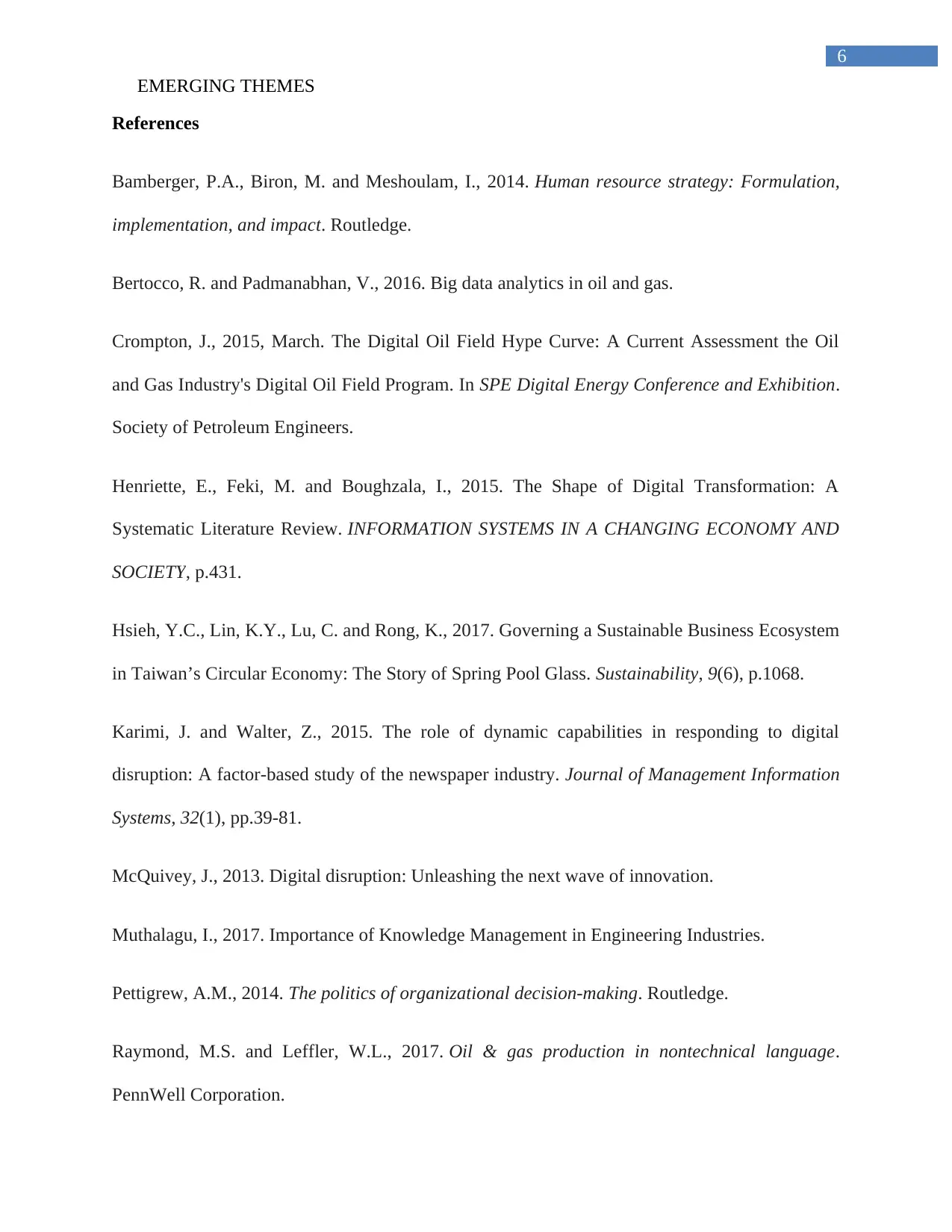
6
EMERGING THEMES
References
Bamberger, P.A., Biron, M. and Meshoulam, I., 2014. Human resource strategy: Formulation,
implementation, and impact. Routledge.
Bertocco, R. and Padmanabhan, V., 2016. Big data analytics in oil and gas.
Crompton, J., 2015, March. The Digital Oil Field Hype Curve: A Current Assessment the Oil
and Gas Industry's Digital Oil Field Program. In SPE Digital Energy Conference and Exhibition.
Society of Petroleum Engineers.
Henriette, E., Feki, M. and Boughzala, I., 2015. The Shape of Digital Transformation: A
Systematic Literature Review. INFORMATION SYSTEMS IN A CHANGING ECONOMY AND
SOCIETY, p.431.
Hsieh, Y.C., Lin, K.Y., Lu, C. and Rong, K., 2017. Governing a Sustainable Business Ecosystem
in Taiwan’s Circular Economy: The Story of Spring Pool Glass. Sustainability, 9(6), p.1068.
Karimi, J. and Walter, Z., 2015. The role of dynamic capabilities in responding to digital
disruption: A factor-based study of the newspaper industry. Journal of Management Information
Systems, 32(1), pp.39-81.
McQuivey, J., 2013. Digital disruption: Unleashing the next wave of innovation.
Muthalagu, I., 2017. Importance of Knowledge Management in Engineering Industries.
Pettigrew, A.M., 2014. The politics of organizational decision-making. Routledge.
Raymond, M.S. and Leffler, W.L., 2017. Oil & gas production in nontechnical language.
PennWell Corporation.
EMERGING THEMES
References
Bamberger, P.A., Biron, M. and Meshoulam, I., 2014. Human resource strategy: Formulation,
implementation, and impact. Routledge.
Bertocco, R. and Padmanabhan, V., 2016. Big data analytics in oil and gas.
Crompton, J., 2015, March. The Digital Oil Field Hype Curve: A Current Assessment the Oil
and Gas Industry's Digital Oil Field Program. In SPE Digital Energy Conference and Exhibition.
Society of Petroleum Engineers.
Henriette, E., Feki, M. and Boughzala, I., 2015. The Shape of Digital Transformation: A
Systematic Literature Review. INFORMATION SYSTEMS IN A CHANGING ECONOMY AND
SOCIETY, p.431.
Hsieh, Y.C., Lin, K.Y., Lu, C. and Rong, K., 2017. Governing a Sustainable Business Ecosystem
in Taiwan’s Circular Economy: The Story of Spring Pool Glass. Sustainability, 9(6), p.1068.
Karimi, J. and Walter, Z., 2015. The role of dynamic capabilities in responding to digital
disruption: A factor-based study of the newspaper industry. Journal of Management Information
Systems, 32(1), pp.39-81.
McQuivey, J., 2013. Digital disruption: Unleashing the next wave of innovation.
Muthalagu, I., 2017. Importance of Knowledge Management in Engineering Industries.
Pettigrew, A.M., 2014. The politics of organizational decision-making. Routledge.
Raymond, M.S. and Leffler, W.L., 2017. Oil & gas production in nontechnical language.
PennWell Corporation.
Paraphrase This Document
Need a fresh take? Get an instant paraphrase of this document with our AI Paraphraser
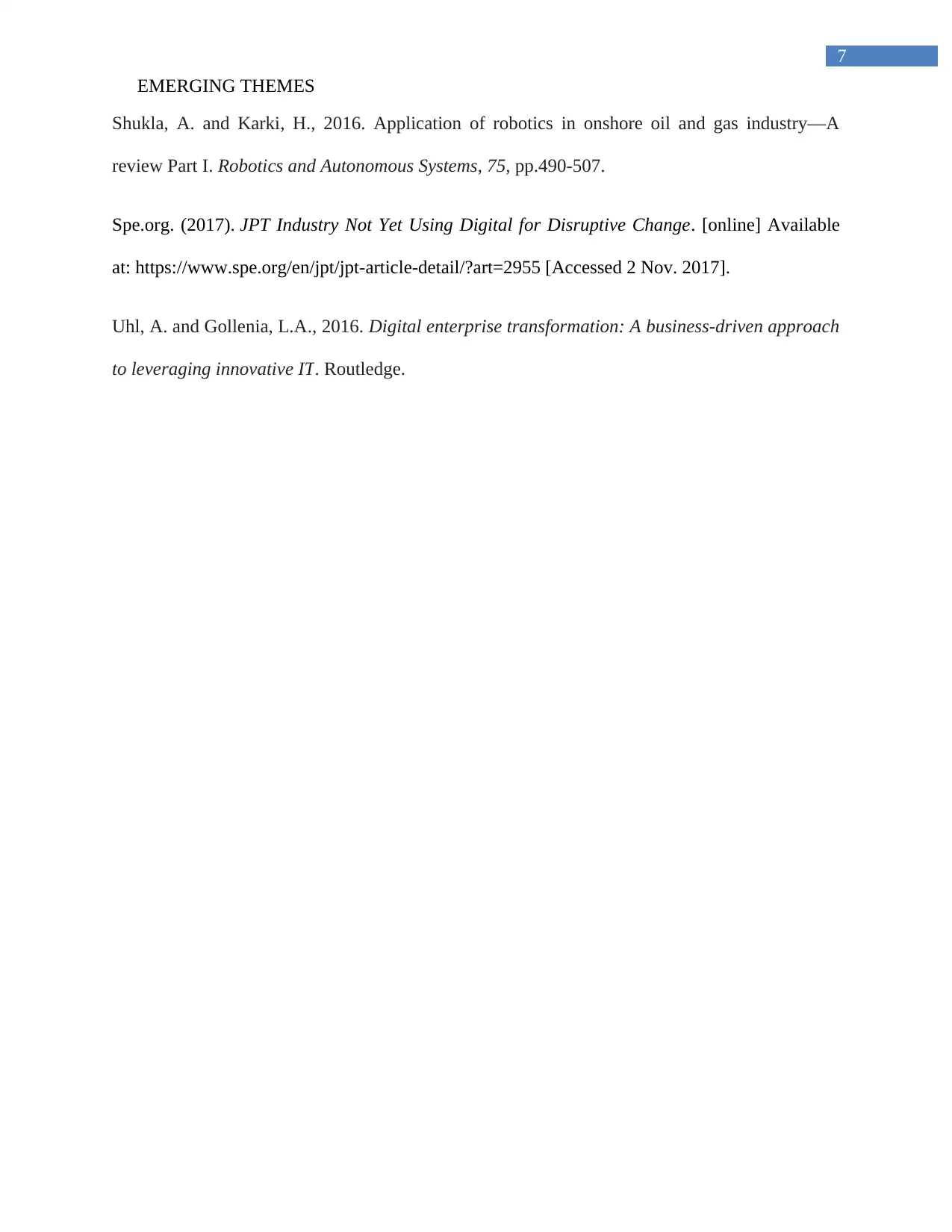
7
EMERGING THEMES
Shukla, A. and Karki, H., 2016. Application of robotics in onshore oil and gas industry—A
review Part I. Robotics and Autonomous Systems, 75, pp.490-507.
Spe.org. (2017). JPT Industry Not Yet Using Digital for Disruptive Change. [online] Available
at: https://www.spe.org/en/jpt/jpt-article-detail/?art=2955 [Accessed 2 Nov. 2017].
Uhl, A. and Gollenia, L.A., 2016. Digital enterprise transformation: A business-driven approach
to leveraging innovative IT. Routledge.
EMERGING THEMES
Shukla, A. and Karki, H., 2016. Application of robotics in onshore oil and gas industry—A
review Part I. Robotics and Autonomous Systems, 75, pp.490-507.
Spe.org. (2017). JPT Industry Not Yet Using Digital for Disruptive Change. [online] Available
at: https://www.spe.org/en/jpt/jpt-article-detail/?art=2955 [Accessed 2 Nov. 2017].
Uhl, A. and Gollenia, L.A., 2016. Digital enterprise transformation: A business-driven approach
to leveraging innovative IT. Routledge.
1 out of 8
Related Documents
Your All-in-One AI-Powered Toolkit for Academic Success.
+13062052269
info@desklib.com
Available 24*7 on WhatsApp / Email
![[object Object]](/_next/static/media/star-bottom.7253800d.svg)
Unlock your academic potential
Copyright © 2020–2025 A2Z Services. All Rights Reserved. Developed and managed by ZUCOL.




